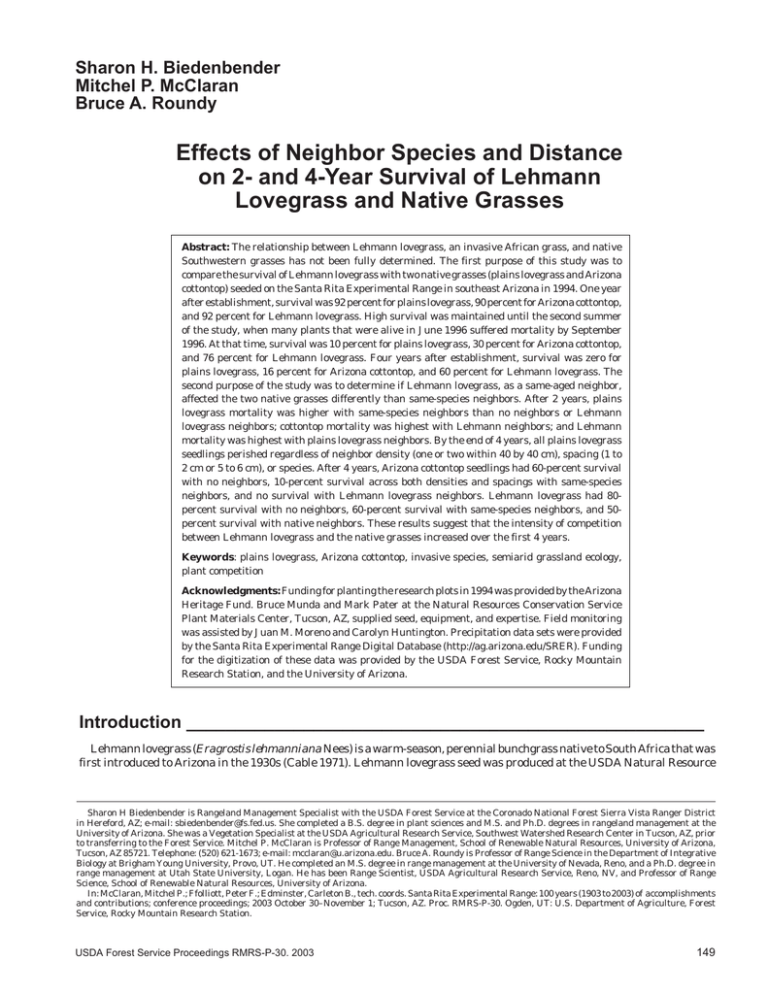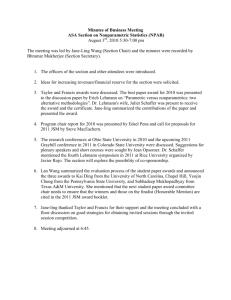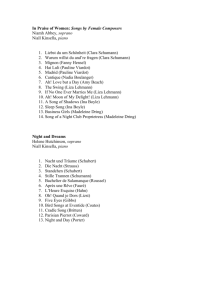Effects of Neighbor Species and Distance Lovegrass and Native Grasses
advertisement

Sharon H. Biedenbender Mitchel P. McClaran Bruce A. Roundy Effects of Neighbor Species and Distance on 2- and 4-Year Survival of Lehmann Lovegrass and Native Grasses Abstract: The relationship between Lehmann lovegrass, an invasive African grass, and native Southwestern grasses has not been fully determined. The first purpose of this study was to compare the survival of Lehmann lovegrass with two native grasses (plains lovegrass and Arizona cottontop) seeded on the Santa Rita Experimental Range in southeast Arizona in 1994. One year after establishment, survival was 92 percent for plains lovegrass, 90 percent for Arizona cottontop, and 92 percent for Lehmann lovegrass. High survival was maintained until the second summer of the study, when many plants that were alive in June 1996 suffered mortality by September 1996. At that time, survival was 10 percent for plains lovegrass, 30 percent for Arizona cottontop, and 76 percent for Lehmann lovegrass. Four years after establishment, survival was zero for plains lovegrass, 16 percent for Arizona cottontop, and 60 percent for Lehmann lovegrass. The second purpose of the study was to determine if Lehmann lovegrass, as a same-aged neighbor, affected the two native grasses differently than same-species neighbors. After 2 years, plains lovegrass mortality was higher with same-species neighbors than no neighbors or Lehmann lovegrass neighbors; cottontop mortality was highest with Lehmann neighbors; and Lehmann mortality was highest with plains lovegrass neighbors. By the end of 4 years, all plains lovegrass seedlings perished regardless of neighbor density (one or two within 40 by 40 cm), spacing (1 to 2 cm or 5 to 6 cm), or species. After 4 years, Arizona cottontop seedlings had 60-percent survival with no neighbors, 10-percent survival across both densities and spacings with same-species neighbors, and no survival with Lehmann lovegrass neighbors. Lehmann lovegrass had 80percent survival with no neighbors, 60-percent survival with same-species neighbors, and 50percent survival with native neighbors. These results suggest that the intensity of competition between Lehmann lovegrass and the native grasses increased over the first 4 years. Keywords: plains lovegrass, Arizona cottontop, invasive species, semiarid grassland ecology, plant competition Acknowledgments: Funding for planting the research plots in 1994 was provided by the Arizona Heritage Fund. Bruce Munda and Mark Pater at the Natural Resources Conservation Service Plant Materials Center, Tucson, AZ, supplied seed, equipment, and expertise. Field monitoring was assisted by Juan M. Moreno and Carolyn Huntington. Precipitation data sets were provided by the Santa Rita Experimental Range Digital Database (http://ag.arizona.edu/SRER). Funding for the digitization of these data was provided by the USDA Forest Service, Rocky Mountain Research Station, and the University of Arizona. Introduction _____________________________________________________ Lehmann lovegrass (Eragrostis lehmanniana Nees) is a warm-season, perennial bunchgrass native to South Africa that was first introduced to Arizona in the 1930s (Cable 1971). Lehmann lovegrass seed was produced at the USDA Natural Resource Sharon H Biedenbender is Rangeland Management Specialist with the USDA Forest Service at the Coronado National Forest Sierra Vista Ranger District in Hereford, AZ; e-mail: sbiedenbender@fs.fed.us. She completed a B.S. degree in plant sciences and M.S. and Ph.D. degrees in rangeland management at the University of Arizona. She was a Vegetation Specialist at the USDA Agricultural Research Service, Southwest Watershed Research Center in Tucson, AZ, prior to transferring to the Forest Service. Mitchel P. McClaran is Professor of Range Management, School of Renewable Natural Resources, University of Arizona, Tucson, AZ 85721. Telephone: (520) 621-1673; e-mail: mcclaran@u.arizona.edu. Bruce A. Roundy is Professor of Range Science in the Department of Integrative Biology at Brigham Young University, Provo, UT. He completed an M.S. degree in range management at the University of Nevada, Reno, and a Ph.D. degree in range management at Utah State University, Logan. He has been Range Scientist, USDA Agricultural Research Service, Reno, NV, and Professor of Range Science, School of Renewable Natural Resources, University of Arizona. In: McClaran, Mitchel P.; Ffolliott, Peter F.; Edminster, Carleton B., tech. coords. Santa Rita Experimental Range: 100 years (1903 to 2003) of accomplishments and contributions; conference proceedings; 2003 October 30–November 1; Tucson, AZ. Proc. RMRS-P-30. Ogden, UT: U.S. Department of Agriculture, Forest Service, Rocky Mountain Research Station. USDA Forest Service Proceedings RMRS-P-30. 2003 149 Biedenbender, McClaran, and Roundy Conservation Service (NRCS, formerly the Soil Conservation Service) Plant Materials Center, Tucson, AZ, and distributed to soil conservationists and scientists within NRCS for field plantings to stabilize soil and increase forage production in Arizona, New Mexico, and Texas. Areas where Lehmann lovegrass successfully establishes have sandy to sandy loam soils to 120 cm deep, mean summer precipitation greater than 200 mm, and winter temperatures that rarely fall below 0 ∞C (Cox and Ruyle 1986). Between 1940 and 1950, Lehmann lovegrass began to spread to areas not intentionally seeded. By the mid-1980s, continued seedings and natural spread allowed Lehmann lovegrass to become the most prevalent grass species on approximately 145,000 ha in southeastern Arizona (Cox and Ruyle 1986), and it is still increasing in land coverage (Anable and others 1992). Lehmann lovegrass may displace native grasses with undesirable ecological consequences such as decreased native wildlife species diversity and abundance (Bock and others 1986), alterations in fire frequency and intensity (Bock and Bock 1992; Cable 1965), and decreased livestock forage quality (Cox and others 1990). Although concern exists regarding the displacement of native grasses by Lehmann lovegrass, the relationship between Lehmann lovegrass and native grasses has not been fully understood. Among the possible mechanisms by which Lehmann lovegrass may compete successfully against native grasses are greater seed production, faster growth rate, lower palatability to herbivores, lower nutrient requirements, and a potential competitive advantage over native range grasses in procuring soil moisture. Many seedling studies indicate that rapid growth rate or large size ensure competitive success (Goldberg 1990). Lehmann lovegrass has been shown to recover from drought more rapidly than native grasses and to spread after drought into areas previously occupied by native grasses (Robinett 1992). Angell and McClaran (2001) found that from 1972 to 2000 native grass species on the Santa Rita Experimental Range (SRER) in southeastern Arizona declined prior to the arrival of Lehmann lovegrass. Abbott and Roundy (2002) showed that Lehmann lovegrass, compared to native grasses, retained a viable seed bank during sporadic early summer precipitation events, hence better ensuring seedling germination and establishment during more consistent late summer rains. In June and August 1992, 1993, and 1994, native grasses were seeded into existing stands of Lehmann lovegrass on the SRER to determine the effects on native grass establishment of mowing, herbicide application, and burning treatments applied to the Lehmann lovegrass canopy (Biedenbender and Roundy 1996). In June 1994 an arson fire consumed the vegetation in the experimental area, killing most mature Lehmann lovegrass plants and negating treatment effects. However, massive recruitment of Lehmann lovegrass seedlings from the seed bank followed rains occurring in August and September of that year. In addition, excellent native grass seedling establishment resulted from the August 1994 planting. To take advantage of this cohort of same-aged Lehmann lovegrass and native grasses, an experiment with different numbers, spacings, and species of neighbors was executed. The first purpose of this study was to compare the survival of Lehmann lovegrass and two native grasses (plains lovegrass, Eragrostis intermedia Hitchc., and Arizona 150 Effects of Neighbor Species and Distance on 2- and 4-Year Survival of... cottontop, Digitaria californica (Benth.) Henr.). The second purpose was to determine if Lehmann lovegrass, as a sameaged neighbor, affected the two native grasses differently than same-species neighbors. Competition is defined as an interaction between two organisms in which both are negatively affected, whereas an amensal interaction is defined as one in which one organism is negatively affected and the other is unaffected by the neighbor (Burkholder 1952). Competition theory suggests that more closely related individuals compete for resources more intensely than distantly related individuals (Keddy 1989). Based on this theory, same-species neighbors would be expected to compete most intensely, and individuals in the same genus might be expected to compete more intensely with each other than with individuals in a different genus. Lehmann lovegrass and plains lovegrass are in the same genus, whereas Arizona cottontop is not. The third purpose was to see if the proximity of neighbors affected survival. Removal experiments can indicate if a reduction in the abundance of one species affects the survival and/or production of another (McPherson and DeStefano 2003). If the removal or reduction in number of one species increases the growth or survival of another, it can be inferred that the removed species was competing with the survivor. This study was a removal experiment designed to evaluate whether, during the early stages of plant establishment, Lehmann lovegrass competes with plains lovegrass and Arizona cottontop, and whether the effects of the interaction increase as the number and proximity of Lehmann lovegrass neighbors increases. Methods ______________________ The study site is located in a livestock exclosure containing a Lehmann lovegrass monoculture with scattered mesquite trees. Average annual precipitation is 450 mm, the soil is a sandy loam, slopes are 2- to 5-percent slope, and elevation is approximately 1,075 m (Biedenbender and Roundy 1996). The precipitation record for 1995 to 1998 was obtained from a SRER rain gage near the study site (fig. 1). The long-term annual average from 1972 to 2002 for this rain gage is 388 mm and the long-term average for July through September is 199 mm. The treatments were installed in December 1994. Quadrats measuring 40 by 40 cm were placed along seeded rows, a target seedling was chosen in the center of each quadrat, and all other vegetation except for the selected neighbors was removed. Target seedlings of Lehmann lovegrass, plains lovegrass, and Arizona cottontop were arranged with no neighbors, one and two same-species neighbors at 1 to 2 and 5 to 6 cm distance, and one and two Lehmann lovegrass neighbors at 1 to 2 and 5 to 6 cm distance (table 1). In addition, quadrats with four Lehmann lovegrass neighbors within 1 to 6 cm were established. Each treatment was replicated five times for a total of N = 150. When two samespecies seedlings shared a plot, the southern or western seedling was designated as the target. Every attempt was made to chose target and neighbor seedlings that were representative of the range of seedling sizes present on the site. Also, target and neighbor seedlings of similar size were selected. These treatments allowed for comparisons among two densities and two distances of same-species neighbors USDA Forest Service Proceedings RMRS-P-30. 2003 Effects of Neighbor Species and Distance on 2- and 4-Year Survival of... seasons until the fall of 1998. Mortality was calculated for 1995 and 1996 based on 50 total possible survivors for each species. For 1997 and 1998 mortality calculations were based on 25 total possible survivors due to the harvest of quadrats at 1 to 2 and 1 to 6 cm spacings. Seasonal and Annual Precipitation SRER 1995 - 1998 Amount (mm) Biedenbender, McClaran, and Roundy 600 500 400 300 200 100 0 Results _______________________ 94 - 95 95 - 96 96 - 97 97 - 98 98 Year Jul - Sep Oct - Jun Figure 1—Seasonal and annual precipitation record (mm) from the IBP (Pasture 21) rain gage on the Santa Rita Experimental Range in southeast Arizona, 1995 to 1998; the rain gage is near the Lehmann lovegrass and native grass survival study; the long-term annual average from 1972 to 2002 was 388 mm (—); the long term average for July through September was 199 mm (- - - -). for all three species and among three densities and two distances for Lehmann lovegrass neighbors. Mortality was determined for target plants in the fall from 1995 through 1998. At the end of the second growing season in the fall of 1996, all quadrats at the 1 to 2 cm and 1 to 6 cm spacing were harvested. Mortality was followed on remaining target plants at the 5 to 6 cm spacing for two more growing Table 1—Treatments for a Lehmann lovegrass and native grass survival study on the Santa Rita Experimental Range in southeast Arizona, 1995 to 1998; native grasses were plains lovegrass and Arizona cottontop; each target seedling had the following arrangement of neighbors. Native treatments 1 No neighbors 2 One same species neighbor at 1 to 2 cm 3 Two same species neighbors at 1 to 2 cm 4 One same species neighbor at 5 to 6 cm 5 Two same species neighbors at 5 to 6 cm 6 One Lehmann lovegrass neighbor at 1 to 2 cm 7 One Lehmann lovegrass neighbor at 5 to 6 cm 8 Two Lehmann lovegrass neighbors at 1 to 2 cm 9 Two Lehmann lovegrass neighbors at 5 to 6 cm 10 Four Lehmann lovegrass neighbors at 1 to 6 cm Lehmann treatments 1 No neighbors 2 One Lehmann lovegrass neighbor at 1 to 2 cm 3 One Lehmann lovegrass neighbor at 5 to 6 cm 4 Two Lehmann lovegrass neighbors at 1 to 2 cm 5 Two Lehmann lovegrass neighbors at 5 to 6 cm 6 Four Lehmann lovegrass neighbors at 1 to 6 cm 7 One Arizona cottontop neighbor at 1 to 2 cm 8 One Arizona cottontop neighbor at 5 to 6 cm 9 One plains lovegrass neighbor at 1 to 2 cm 10 One plains lovegrass neighbor at 5 to 6 cm USDA Forest Service Proceedings RMRS-P-30. 2003 When measured in 1995 the first spring after planting, there was no mortality of target seedlings. In October 1995, 1 year after establishment, total survival across all treatments was 92 percent for plains lovegrass, 90 percent for Arizona cottontop, and 92 percent for Lehmann lovegrass (table 2; fig. 2). High survival was maintained until the second summer of the study, but many plants had suffered mortality by September 1996. At that time, plains lovegrass survival was only 10 percent, Arizona cottontop fared somewhat better with 30 percent, and Lehmann lovegrass survival was an impressive 76 percent. A pattern of winter/ spring growth followed by summer mortality was noted in 1995 and repeated in 1996. Mortality during their second summer even befell plants among all three species that had achieved considerable size. Three years after establishment, survival in November 1997 was zero for plains lovegrass, 24 percent for Arizona cottontop, and remained at 76 percent for Lehmann lovegrass. Four years after establishment, survival in November 1998 was 16 percent for Arizona cottontop and 60 percent for Lehmann lovegrass. Plains lovegrass mortality was higher with same-species neighbors than no neighbors or Lehmann lovegrass neighbors (table 2; fig. 3). Cottontop mortality was highest with Lehmann lovegrass neighbors, and Lehmann mortality was highest with plains lovegrass neighbors. By the end of 4 years, all plains lovegrass seedlings perished regardless of neighbor density (one or two within 40 by 40 cm), spacing (1 to 2 cm or 5 to 6 cm), or species. After 4 years, Arizona cottontop seedlings had 60-percent survival with no neighbors, 10-percent survival across both densities and spacings with same-species neighbors, and zero survival with Lehmann lovegrass neighbors. Lehmann lovegrass had 80percent survival with no neighbors, 60-percent survival with same-species neighbors, and 50-percent survival with native neighbors, 80 percent with cottontop, and only 20 percent with plains lovegrass (table 2). Discussion ____________________ First-year seedling survival for Arizona cottontop and plains lovegrass was very high and equal to or only somewhat less than Lehmann lovegrass. However, over the next 3 years, Lehmann lovegrass survival surpassed the natives for all of the species-spacing treatments. This study suggests that competitive release activated by the removal of neighbors benefited all three species. Plants with no neighbors within the 40- by 40-cm quadrats had the best survival both short and long term. There was little difference in survival between plants with neighbors at 1 to 2 or 5 to 6 cm. Results were mixed with respect to evidence for greater competition from more closely related neighbors. Plains lovegrass seemed to support the theory, having its lowest survival rate with same-species neighbors. Cottontop, however, had its lowest 151 Biedenbender, McClaran, and Roundy Effects of Neighbor Species and Distance on 2- and 4-Year Survival of... Table 2—Four-year survival (percent) across all treatments for Lehmann lovegrass and native grasses having no neighbors, same-species neighbors, or Lehmann lovegrass neighbors on the Santa Rita Experimental Range in southeast Arizona, 1995 to 1998. October 1995 September 1996 Plains lovegrass No neighbors Plains neighbors Lehmann neighbors Total survival 100 85 96 92 20 5 12 10 0 0 0 0 0 0 0 0 Arizona cottontop No neighbors Cottontop neighbors Lehmann neighbors Total survival 100 80 88 90 100 40 12 30 80 20 0 24 60 10 0 16 Lehmann lovegrass No neighbors Lehmann neighbors Plains neighbors Cottontop neighbors Total survival 100 100 70 90 92 80 96 40 60 76 80 90 20 100 76 80 60 20 80 60 survival rate with neighbors of its most distant relative, Lehmann lovegrass. Lehmann lovegrass experienced its lowest survival rate with plains lovegrass neighbors, its second lowest rate with same-species neighbors, with no difference between cottontop neighbors and no neighbors. The timing of the greatest mortality for all three species, but especially plains lovegrass and cottontop, suggests that the 2-year-old Lehmann lovegrass plants in this study survived seasonal drought better. The young native and Lehmann lovegrass plants survived their first dry springearly summer period in 1996, and most were still alive at the June 1996 census. However, between that census and the following one in September, most of the plains lovegrass and cottontop plants perished, whereas many Lehmann lovegrass plants survived. The precipitation record from a nearby rain gage (fig. 1) indicates that both 1995 and 1996 were below average in total annual precipitation (388 mm from 1972 to 2002) and below average in summer precipitation (199 mm for July through September from 1972 to 2002), but they differed in their temporal distribution patterns. Summer moisture was greater in 1996 than 1995, but less for the remainder of the year. Interestingly, there was high survival through the June 1996 census followed by abrupt decline in size or death for most treatments by September. Perhaps a moisture availability threshold was crossed at which plants could no longer sustain life; perhaps as the plants grew larger they required more moisture for survival. In any case, it appears from this study that Lehmann lovegrass survived low moisture availability better than plains lovegrass and Arizona cottontop. It also appears that over the 4 years of this study, the competitive relationship between Lehmann lovegrass and the two native species became stronger and shifted towards amensalism, with Lehmann lovegrass as a neighbor negatively affecting the two natives to a greater extent than they were able to affect Lehmann lovegrass. Abbott and Roundy (2003) recommend seeding native grasses for revegetation in southeast Arizona in mid to late 152 November 1997 November 1998 summer. Sporadic early summer rains stimulate native grass germination, but seedlings perish during ensuing dry periods that precede the more reliable rainfall events that typically begin in July. Lehmann lovegrass seeds delay germination until soil moisture reserves are better insured by later summer rains. This study followed Lehmann lovegrass and two native grasses from establishment into adulthood and demonstrated that even successfully established native grasses succumbed to seasonal and annual drought conditions that Lehmann lovegrass plants of the same age survived. Because the intensity of competition between Lehmann lovegrass and the native species increased over time, the sequestration of water resources between neighboring adults may be more limiting than between neighboring seedlings. Alternatively, native grasses may die during drought regardless of whether Lehmann lovegrass is present, and Lehmann lovegrass may colonize sites following native grass decline, as documented on the SRER by Angell and McClaran (2001). The management implications of these findings are not encouraging for revegetation with native grasses in areas where Lehmann lovegrass exists or has the potential to establish. Without Lehmann lovegrass, native grass stands would be expected to recover following drought, but once Lehmann lovegrass is present, it may prevent native recovery. References ____________________ Abbott, L. B.; Roundy, B. A. 2003. Available water influences field germination and recruitment of seeded grasses. Journal of Range Management. 56: 56–64. Anable, M. E.; McClaran, M. P.; Ruyle, G. B. 1992. Spread of introduced Lehmann lovegrass Eragrostis lehmanniana Nees. in southern Arizona, USA. Biology Conservation. 61: 181–188. Angell, D. L.; McClaran, M. P. 2001. Long-term influences of livestock management and a non-native grass on grass dynamics in the Desert Grassland. Journal of Arid Environments. 49: 507–520. USDA Forest Service Proceedings RMRS-P-30. 2003 Effects of Neighbor Species and Distance on 2- and 4-Year Survival of... Biedenbender, McClaran, and Roundy Figure 2—Two-year fall survival for plains lovegrass, Arizona cottontop, and Lehmann lovegrass on the Santa Rita Experimental Range in southeast Arizona, 1995 to 1996; target plants had no neighbors, one or two same-species neighbors, or Lehmann lovegrass neighbors at 1 to 2 or 5 to 6 cm spacing. Figure 3—Four-year fall survival for plains lovegrass, Arizona cottontop, and Lehmann lovegrass on the Santa Rita Experimental Range in southeast Arizona, 1995 to 1998; target plants had no neighbors, one or two same-species neighbors, or Lehmann lovegrass neighbors at 5 to 6 cm spacing. Biedenbender, S. H.; Roundy, B. A. 1996. Establishment of native semidesert grasses into existing stands of Eragrostis lehmanniana in southeastern Arizona. Restoration Ecology. 4: 155–162. Bock, C. E.; Bock, J. H.; Jepson, K. L.; Ortega, J. C. 1986. Ecological effects of planting African lovegrasses in Arizona. Natural Geographic Research. 2: 456–463. Bock, J. H.; Bock, C. E. 1992. Vegetation response to wildfire in native versus exotic Arizona grassland. Journal of Vegetation Science. 3: 439–446. Burkholder, P. R. 1952. Cooperation and conflict among primitive organisms. American Scientist. 40: 601–631. Cable, D. R. 1965. Damage to mesquite, Lehmann lovegrass, and black grama by a hot June fire. Journal of Range Management. 18: 326–329. Cable, D. R. 1971. Lehmann lovegrass on the Santa Rita Experimental Range, 1937–1968. Journal of Range Management. 24: 17–21. Cox, J. R.; Ruyle, G. B. 1986. Influence of climatic and edaphic factors on the distribution of Eragrostis lehmanniana Nees in Arizona, USA. Journal of Grassland Society of South Africa. 3: 25–29. Cox, J. R.; Ruyle, G. B.; Roundy, B. A. 1990. Lehmann lovegrass in southeastern Arizona: biomass production and disappearance. Journal of Range Management. 43: 367–372. Goldberg, D. E. 1990. Components of resource competition in plant communities. In: Grace J. B.; Tilman, D., eds. Perspectives on plant competition. San Diego, CA: Academic Press: 27–57. Keddy, P. A. 1989. Competition. Population and community biology series. London: Chapman & Hall: 90–97. McClaran, M. P.; Angell, D. L.; Wissler, C. 2002. Santa Rita Experimental Range Digital Database: user’s guide. Gen. Tech. Rep. RMRS-100. Fort Collins, CO: U.S. Department of Agriculture, Forest Service, Rocky Mountain Research Station. 13 p. McPherson, G. R.; DeStefano, S. 2003. Applied ecology and natural resource management. Cambridge University Press: 17–36. Robinett, D. 1992. Lehmann lovegrass and drought in southern Arizona. Rangelands 14: 100–103. USDA Forest Service Proceedings RMRS-P-30. 2003 153




